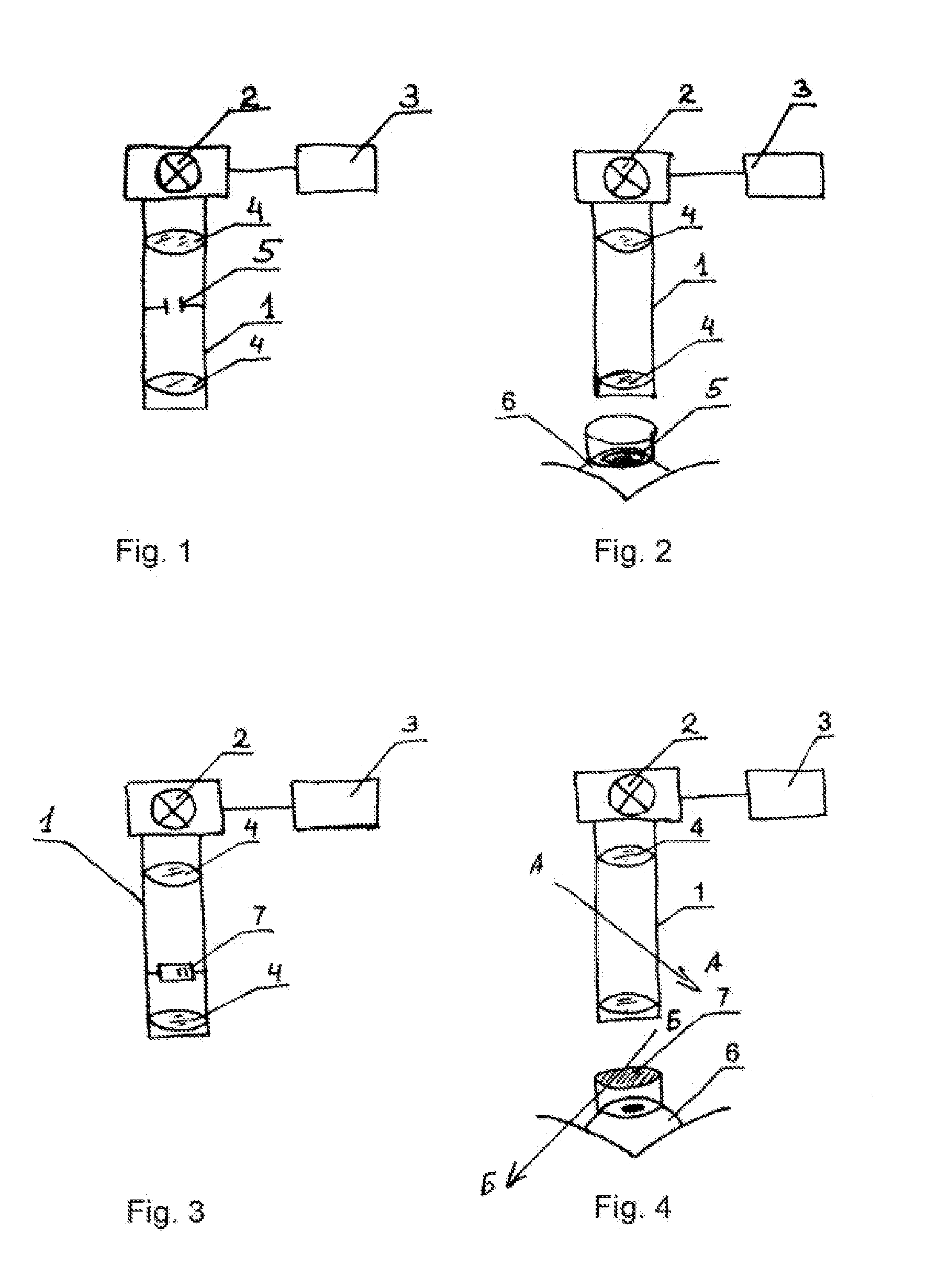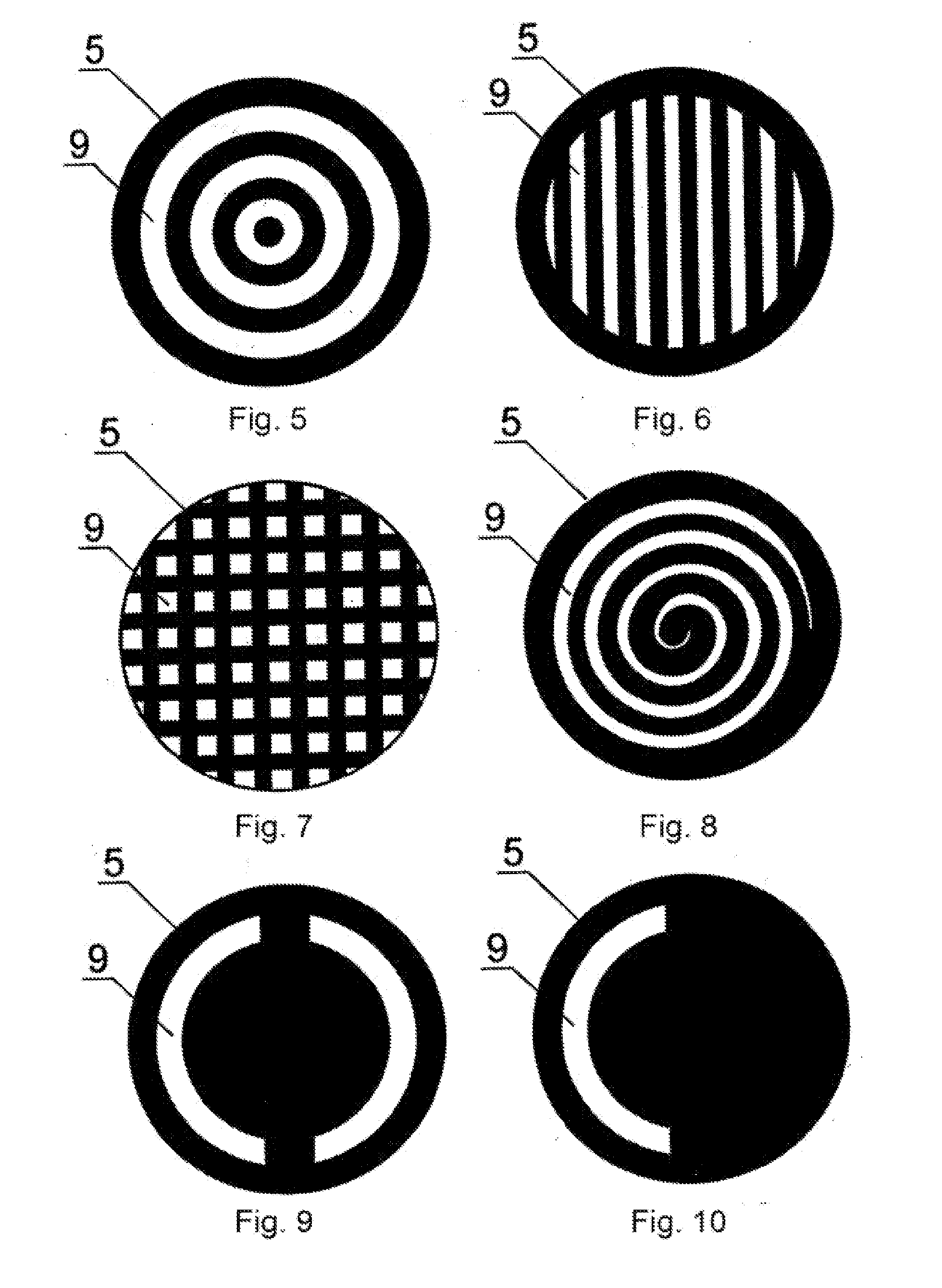Method for treating keratoconus by UV radiation and a device for carrying out said method (variants)
a technology of keratoconus and uv radiation, which is applied in the field of keratoconus treatment by uv radiation and a device for carrying out said method, can solve the problems of traumatic method and affect the damage of endothelial cells, and achieve the effect of reducing the adverse effects of exposur
- Summary
- Abstract
- Description
- Claims
- Application Information
AI Technical Summary
Benefits of technology
Problems solved by technology
Method used
Image
Examples
example 1
Patient A., Aged 26
[0025]Diagnosis: keratoconus of both eyes. Visual acuity before surgery:
right eye—0,01 sph—4,0 D, cyl—4,0 D ax 85°
left eye—0,2 sph—1,5 D, cyl—1,5 D ax 95°
[0026]Intensive disease progression is present over the past six months.
[0027]Surgery was carried out according to the suggested method. After the local anesthesia photomediator instillation is provided, namely the solution of 1% riboflavin within 30 minutes. Then on the corneal surface the diaphragm image of concentric rings formed by the UV source was focused. The exposition was 1 minute.
[0028]The next day after surgery—right eye calm, zero degree reaction, no soreness, and no signs of cornea damage seen on slit lamp examination. Control examination after 1 year showed no disease progression in the right eye. The same method was used for the treatment of the left eye.
example 2
Patient B., 28 Years Old
[0029]Diagnosis: keratoconus of both eyes. Visual acuity before surgery:
right eye —0,01 sph—2,0 D, cyl—5,0 D ax 65°
left eye—0,1 sph—1,5 D, cyl—3,5 D ax 105°
[0030]Intensive disease progression is present over the past six months.
[0031]Surgery was carried out according to the suggested method. After the local anesthesia photomediator instillation is provided, namely the solution of 1% riboflavin within 30 minutes, on the surface of the cornea aperture in the form of parallel lines was set, it was formed by the UV source, the direction of the lines was chosen to be parallel to the astigmatism axis, i.e., parallel to the meridian 65 degrees. Diaphragm was fixed with a vacuum ring. The exposition was 30 minutes.
[0032]The next day after surgery—right eye calm, zero degree reaction, no soreness, and no signs of cornea damage seen on slit lamp examination. Control examination after 1 year showed no disease progression in the right eye. The same method was used for th...
example 3
Patient Sh., Aged 38
[0033]Diagnosis: keratoconus of both eyes. Visual acuity before surgery:
right eye—0,01 sph—0,5 D, cyl—4,0 D ax 75°
left eye—0,2 cyl—3,75 D ax 80°
[0034]Deterioration of vision during the last year.
[0035]Surgery was carried out according to the suggested method. Cornea polarization plane was defined with the polarimeter. Local anesthesia was applied. After photomediator instillation, namely the solution of 1% riboflavin within 30 minutes, the polarization plane of the device polarizer deployed at 90 degrees to the cornea polarization plane. On the right eye cornea surface was focused spot formed by the UV source. The exposition was 40 minutes.
[0036]The next day after surgery—right eye calm, zero degree reaction, no soreness, and no signs of cornea damage seen on slit lamp examination. Control examination after 1 year showed no disease progression in the right eye.
PUM
 Login to View More
Login to View More Abstract
Description
Claims
Application Information
 Login to View More
Login to View More - R&D
- Intellectual Property
- Life Sciences
- Materials
- Tech Scout
- Unparalleled Data Quality
- Higher Quality Content
- 60% Fewer Hallucinations
Browse by: Latest US Patents, China's latest patents, Technical Efficacy Thesaurus, Application Domain, Technology Topic, Popular Technical Reports.
© 2025 PatSnap. All rights reserved.Legal|Privacy policy|Modern Slavery Act Transparency Statement|Sitemap|About US| Contact US: help@patsnap.com



